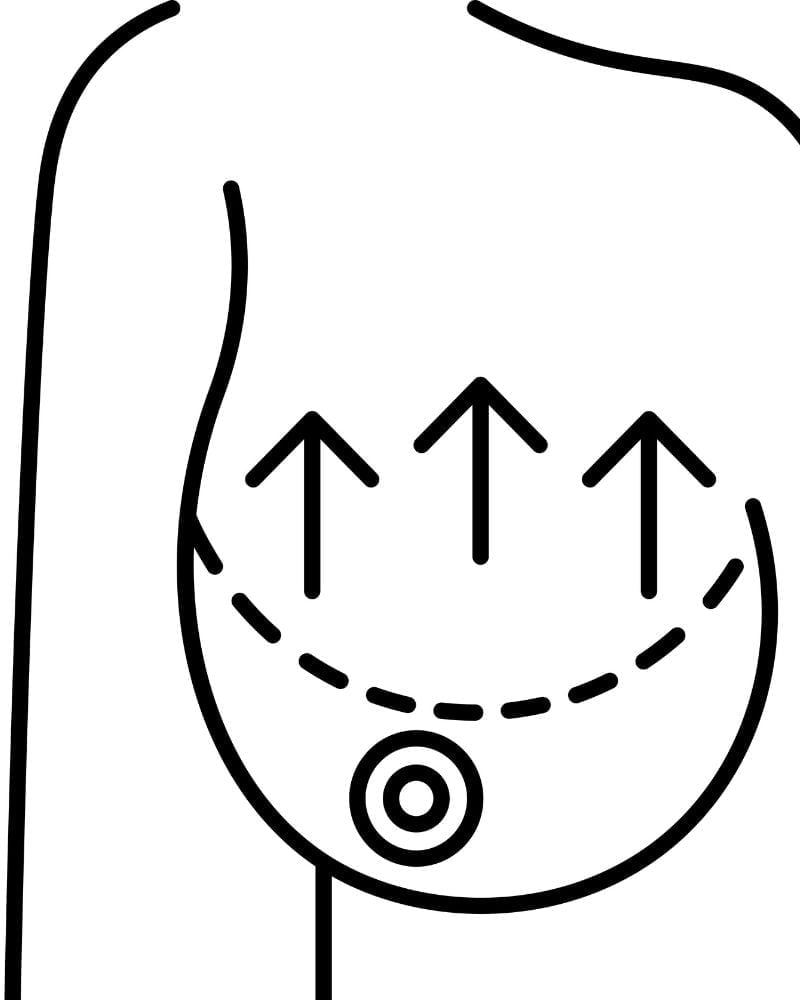Breast Lift
Breast lift works to restore youthful contours.

Breast Ptosis
Drooping and sagging of the breasts often result from diminished breast elasticity with pregnancy, advanced age, or weight loss. This is medically known as breast ptosis. The objective of this webpage is to provide insight into the severity of droopy breasts and surgical procedures to correct them.
Breast lift surgery to restore feminine, firm, and youthful-looking breasts is also referred to as mastopexy. The severity of breast ptosis often influences the type of breast lift performed. A simple classification to define the severity of breast ptosis is described below.
Breast Ptosis Classification
How do you know you have breast ptosis?
Sagging of the breast can be easily seen while standing bare-chested in front of a mirror. Breast ptosis is best visualized by the placement of a standard ruler or measuring tape under the breasts. The top edge of the ruler should be positioned to make contact with the crease that is formed where the breast meets the chest. Any breast positioned below the inframammary crease is classified as ptosis. The nipple position relative to the inframammary crease is used to grade the severity of breast ptosis.
Grading the Severity: Nipple Position
If your nipple, not the colored skin around the nipple (known as areola), is above the top of the ruler—congratulations, you are not considered to have breast ptosis. However, you may have what is known as pseudoptosis if the lower part of your breast gland hangs down too far.
The ruler method is an approximation and Dr. Chen Lee may describe the sagging of your breasts differently.
Treatment of Breast Sag
The medical term, mastopexy is known as a breast lift surgery, and it can correct the appearance of drooping and/or sagging breasts. There are many reasons a women’s breast loses shape such as growing older, pregnancy, and weight loss. Breast sagging’s technical term is ptosis, in which a breast lift procedure is a great option to restore firm and youthful-looking breasts.
A role for breast implants?
Breast augmentation without using breast lift techniques can be effective with mild glandular ptosis and grade 1 breast sag. In more severe cases of breast ptosis, breast lift surgery techniques are essential to reposition the nipple and reduce the external volume of the breast. Breast implants are often used to accentuate the upper chest as part of lifting procedures for more severe cases of breast sag.
Breast Lift Surgery
Dr. Chen Lee will recommend the type of breast lift procedure through the degree of ptosis and the structure of your breast.
Crescent Breast Lift
A common method to correct a mild (grade I) ptosis is through a crescent breast lift known as a crescent lift or nipple lift. In this breast lift procedure, a crescent of skin above your areola is removed from above the nipple, allowing the breast to be reshaped and the nipple moved up.
Benelli Breast Lift
The Benelli breast lift has many terms such as doughnut mastopexy, circumareolar breast lift, and apex lift. The Benelli procedure is considered to be less invasive than other breast lift procedures. The breast is lifted by excising a doughnut-shaped piece of skin encircling the areola. The nipple and areola are lifted by reattaching the breast in an elevated position. The resulting scar surrounds the outer margin of the areolar. This surgical procedure is often used with breast implants for mild grades of ptosis (grade I or II).
Vertical Mastopexy
Vertical mastopexy has a variety of names including vertical breast lift, LeJour lift, and modified Benelli. Patients with moderate breast ptosis (grade 2) will gain greater lift and tightening than with the Benelli procedure. Similar to the Benelli lift, a vertical mastopexy commences with an excision of a doughnut-shaped skin excision. Additionally, a vertical incision from under the areola to the inframammary breast crease is excised to provide an added superior lift to the breast. The vertical mastopexy provides a greater lift than can be achieved with the Benelli procedure. However, it’s less than the full mastopexy (discussed below).
Full Mastopexy Breast Lift
Women who suffer a severe grade of ptosis can be treated with full mastopexy. The full mastopexy breast lift has alternative names such as anchor lift or inverted T breast lift. This procedure can correct severe grade III ptosis by excising an omega pattern of skin and closing the incisions with an anchor patterned scar. The skin excision is designed at the base of the areola and travels to the bottom of the breast, where it meets the ribcage. The sagging breast skin is tightened by excising the tissue from around the areola, down to the inframammary crease, and along the fold where the breast meets the rib cage. Finally, the nipple is elevated to the apex of the breast to achieve a more youthful breast contour. Maximum tightening of the breast envelope can be achieved with a full mastopexy breast lift.

To reduce the need for multiple operations, breast augmentation is often performed in conjunction with breast lift surgery to obtain fuller, firmer, and perkier breasts.
Breast Lift Scars
Incision location determines the location of the final scar. Surgical planning is important to position scars at natural anatomical transition points. Most breast lift designs aim to excise excess skin adjacent to the areola and at the inframammary crease. The vertical mastopexy procedure uses a keyhole incision and the looking of a “lollipop” scar. The full mastopexy incision follows an “anchor” shaped scar. The resulting scars can be hidden by bathing suits, bras, and even low-cut tops. However, some women consider the scarring from a breast lift to be a serious drawback to the procedure.
Are you a candidate for breast lift surgery?
Occasionally, a breast may sag without the descent of the nipple and the condition is known as pseudoptosis or glandular ptosis. Dr. Chen Lee’s experience has led to favor breast augmentation to treat pseudoptosis. Nevertheless, true ptosis will require a breast lift procedure. A breast lift may be performed by itself or in conjunction with breast augmentation. To truly determine whether you need a breast lift and/or breast augmentation, it can only be through a medical examination. Dr. Chen Lee will take specific measurements to determine where the nipple and areola are placed relative to the breast crease (inframammary fold). The measurements will be used to determine if fullness can be restored with breast implants alone or if a breast lift to help restore a youthful look.
Next Steps…
To learn more about a procedure or book a consultation
